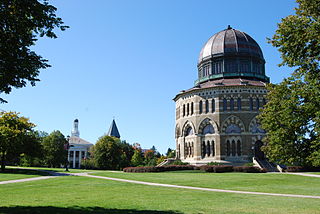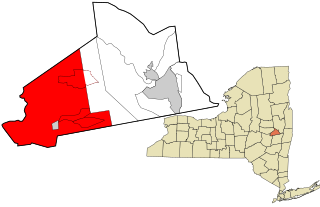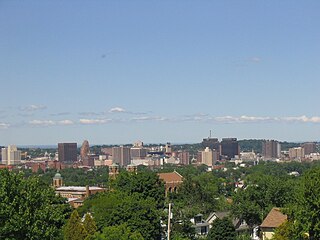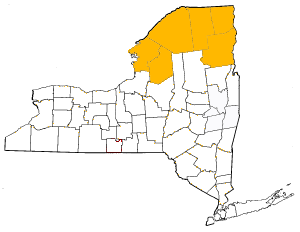
Albany County is a county in the state of New York, United States. Its northern border is formed by the Mohawk River, at its confluence with the Hudson River, which is to the east. As of the 2020 United States Census, the population was 314,848. The county seat and largest city is Albany, which is also the state capital of New York. As originally established by the English government in the colonial era, Albany County had an indefinite amount of land, but has had an area of 530 square miles (1,400 km2) since March 3, 1888. The county is named for the Duke of York and of Albany, who became James II of England.

Schenectady County is a county in the U.S. state of New York. As of the 2020 census, the population was 158,061. The county seat is Schenectady. The name is from a Mohawk language word meaning "on the other side of the pine lands," a term that originally applied to Albany.

Schoharie County is a county in the U.S. state of New York. As of the 2020 census, the population was 29,714, making it the state's fifth-least populous county. The county seat is Schoharie. "Schoharie" comes from a Mohawk word meaning "floating driftwood." Schoharie County is part of the Albany-Schenectady-Troy, NY Metropolitan Statistical Area.

Brunswick is a town in Rensselaer County, New York, United States. The municipality was originally settled in the early 18th century. During its history, it had been part of Albany County, Rensselaerswyck, and Troy, before its incorporation in 1807. It is bordered on the west by the city of Troy; on the north by Schaghticoke and Pittstown; on the east by Grafton; and on the south by Poestenkill and North Greenbush. The population was 11,941 at the 2010 census. The source of the town's name is not certain, though some claim it comes from the source of its first inhabitants from the province of Brunswick-Lüneburg in Germany.

Duanesburg is a town in Schenectady County, New York, United States. The population was 6,122 at the 2010 census. Duanesburg is named for James Duane, who held most of it as an original land grant. The town is in the western part of the county.

The Capital District, also known as the Capital Region, is the metropolitan area surrounding Albany, the capital of the U.S. state of New York. The Capital District was first settled by the Dutch in the early 17th century and came under English control in 1664. Albany has been the permanent capital of the state of New York since 1797. The Capital District is notable for many historical events that predate the independence of the United States, including the Albany Plan of Union and the Battles of Saratoga.

The U.S. state of New York currently comprises 26 congressional districts. Each district elects one member of the United States House of Representatives who sits on its behalf. The state was redistricted in 2022, following the 2020 U.S. census. It lost one seat in Congress.

New York State Route 7 (NY 7) is a 180.30-mile-long (290.16 km) state highway in New York in the United States. The highway runs from Pennsylvania Route 29 (PA 29) at the Pennsylvania state line south of Binghamton in Broome County, New York, to Vermont Route 9 (VT 9) at the Vermont state line east of Hoosick in Rensselaer County. Most of the road runs along the Susquehanna Valley, closely paralleling Interstate 88 (I-88) throughout that road's length. Portions of the highway route near the cities of Binghamton, Schenectady, and Troy date back to the early 19th century.
Watervliet was a town that at its height encompassed most of present-day Albany County and most of the current town of Niskayuna in neighboring Schenectady County, in the state of New York, United States. Just prior to its dissolution, the town encompassed the current towns of Colonie and Green Island and the city of Watervliet.
The towns and cities of Downstate New York were created by the U.S. state of New York as municipalities in order to give residents more direct say over local government. Present-day Westchester, Bronx, New York, Richmond, Kings, Queens, Nassau, and Suffolk counties were part of York Shire from 1664-August 1673 and again from February 1674 until 1683 at which point the Province of New York was divided into counties. From August 1673 to February 1674 New York was under Dutch control and English political units were suspended, then restored under English rule. York Shire was divided into three divisions called ridings, the East, West, and North ridings. In 1683 the colony of New York eliminated shires and ridings in favor of counties, the East Riding becoming Suffolk County, West Riding the counties of Richmond and Kings, while the North Riding became the counties of Westchester, New York, and Queens.

The towns and cities of the Hudson Valley were created by the U.S. state of New York as municipalities, in order to perform the services of local government. In 1683, prior to the creation of modern towns, the Province of New York was divided into twelve counties for administrative purposes by the Colonial Governor of New York. In the Hudson Valley, these divisions included Dutchess, Orange, and Ulster counties. Dutchess and Orange remained unorganized until 1713, with Dutchess administered from Ulster; Orange would be administered from New York County. Future counties would be formed and towns exchanged over time, with Rockland County split from Orange in 1799, at which time the southern towns of Ulster were transferred to Orange as compensation for the loss; and Putnam County from Dutchess in 1812, these county's towns can trace their origins to towns and precincts that were formed in their parent counties. Another change that occurred was the transfer of Dutchess County's northern section, the Livingston Manor, to Columbia County. Greene County was formed in 1800 by the combination of the southernmost towns of Albany County with the northernmost towns of Ulster. The history of the towns of Greene and Columbia counties can be found at the Timeline of town creation in New York's Capital District.

The towns and cities of Central New York were created by the U.S. state of New York as municipalities in order to give residents more direct say over local government. Central New York is a six county area–Cayuga, Herkimer, Madison, Oneida, Onondaga, and Oswego.

The towns and cities of New York's North Country were created by the U.S. state of New York as municipalities in order to give residents more direct say over local government. The North Country consists of Clinton County, Essex County, Franklin County, Jefferson County, Lewis County, and St. Lawrence County. When counties were first formed in 1683 the entire area was theoretically under the jurisdiction of Albany County though actually wilderness inhabited by Native Americans, by 1764 most of the area became effectively controlled by Albany County. The state would sell off this land to settlers and speculators, most notably as part of the Old Military Tract (1786) to veterans of the US Revolutionary War and as Macomb's Purchase (1791) to Alexander Macomb. In 1772 the northern and western portions of Albany County was divided into two counties– Tryon and Charlotte. Tryon encompassed Lewis, Jefferson, and St. Lawrence counties along with the western section of Franklin; Tryon was renamed Montgomery in 1784. Charlotte encompassed Clinton, Essex, and the majority of Franklin County; the name of the county was changed to Washington County in 1784. In 1788 Clinton County was split from Washington, Essex was formed from Clinton in 1799 and Franklin was formed from Clinton in 1808. Montgomery County's North Country area went to Herkimer County on that county's formation in 1791, but western Franklin and eastern St. Lawrence were returned to Montgomery in 1797. In 1798 Lewis, Jefferson, and western St. Lawrence became part of the newly formed Oneida County from Herkimer in 1798, leaving only central St. Lawrence County as part of Herkimer. In 1801 the future St. Lawrence and Franklin counties which were portions of Montgomery, Herkimer, and Oneida were transferred to Clinton County; the next year in 1802 St. Lawrence was formed as a county. In 1805 both Lewis and Jefferson counties were formed from Oneida County.

The 38th New York State Legislature, consisting of the New York State Senate and the New York State Assembly, met from September 26, 1814, to April 18, 1815, during the eighth year of Daniel D. Tompkins's governorship, in Albany.

The 65th New York State Legislature, consisting of the New York State Senate and the New York State Assembly, met from January 4 to September 7, 1842, during the fourth year of William H. Seward's governorship, in Albany.

The 69th New York State Legislature, consisting of the New York State Senate and the New York State Assembly, met from January 6 to May 13, 1846, during the second year of Silas Wright's governorship, in Albany.

The 70th New York State Legislature, consisting of the New York State Senate and the New York State Assembly, met from January 5 to December 15, 1847, during the first year of John Young's governorship, in Albany.
Charles A. Fowler was an American lawyer and politician from New York.















